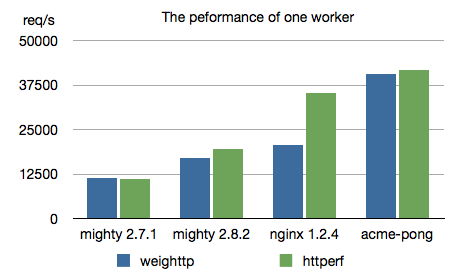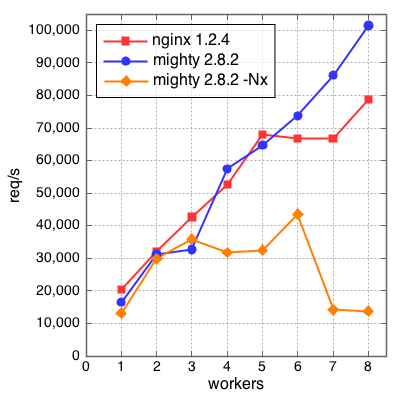This is sixth article for the series of "Improving the performance of Warp". Readers are supposed to read the following articles:
- Improving the performance of Warp
- Sending header and body at once
- Caching file descriptors
- Composing HTTP response headers
- Avoiding system calls
In this article, I will finally show you the results of "ping-pong" benchmarks.
Measuring one worker
My benchmark environment is as follows:
- One "12 cores" machine (Intel Xeon E5645, two sockets, 6 cores per 1 CPU, two QPI between two CPUs)
- Linux version 3.2.0 (Ubuntu 12.04 LTS), which is running directly on the machine (i.e. without a hypervisor)
Target web servers are as follows:
- mighty 2.7.1: Mighty without performance improvements described in this series
- mighty 2.8.2: Mighty with performance improvements described in this series
- nginx 1.2.4: the current stable version of
nginx - acme-pong: the pong program included in the acme-http package
Mighty 2.8.1 includes all improvements which I descried so far except the http-types hack. "acme-pong" is not a practical web server. It is a reference implementation to determine the upper-bound on Haskell web-server performance.
I tested several benchmark tools in the past and my favorite one is httperf. I used httperf for the benchmark in this article:
httperf --hog --num-conns 1000 --num-calls 100 --rate 100000 --server 127.0.0.1 --port 8000 --uri /This means that 1,000 HTTP connections are established and each connection sends 100 requests. To my experience, we can think that "rate 100,000" is the maximum request rate.
For all requests, the same index.html file is returned. I used nginx's index.html whose size is 151 bytes. As "127.0.0.1" suggests, I measured web servers locally. I should have measured from a remote machine but I don't have suitable environment at this moment.
httperf is a single process program using the select() system calls. So, if target web servers can utilize multi cores, it reaches its performance boundary. Andreas suggested weighttp to me as an alternative. It is based on the epoll system call family and can use multiple native threads. I used weighttp as follows:
weighttp -n 100000 -c 1000 -t 3 -k http://127.0.0.1:8000/Like httperf's case, 1,000 HTTP connections are established and each connection sends 100 requests. Additionally, 3 native threads are spawn.
Since Linux has many control parameters, we need to configure the parameters carefully. You can find a good introduction about Linux parameter tuning in ApacheBench & HTTPerf.
I carefully configured both Mighty and nginx as follows:
- using file descriptor cache
- no logging
- no rate limitation
Here is the result of benchmarks for one worker:

Y-axis means throughput whose unit is requests per second. Of course, the larger, the better. What I can see from this results are:
- Mighty 2.8.2 is better than Mighty 2.7.1
nginxhas better throughput than Mighty 2.8.2. The result ofweighttpand that ofhttperfare very different. I don't know why.- acme-pong suggests there would be more room that we can improve the performance of Mighty/Warp.
Measuring multiple workers
Since multi-cores is getting more popular, benchmarks for multiple workers would be interesting. Due to the performance limitation, we cannot use httperf for this purpose. Since my machine has 12 cores and weighttp uses three native threads, I measured web servers from one worker to eight workers(to my experience, three native thread is enough to measure 8 workers). Here is the result:

X-axis is the number of workers and y-axis means throughput whose unit is requests per second. "mighty 2.8.2" (blue) increases workers using the prefork technique while "mighty 2.8.2 -Nx" (orange) increases capabilities with the "-RTS -Nx" option. My observations are:
nginxdoes not scale if the number of workers is larger than 5.- Mighty 2.8.2 with the prefork technique does scale at least for 8 workers
- Increasing capabilities of GHC's threaded RTS cannot utilize multi cores if the number of capabilities is larger than 3.
Also, Andreas and I measured Mighty 2.8.2 with Andreas's parallel IO manager. We had very good results but I don't think it is the proper time to show the results. I hope we can open our results in the future.